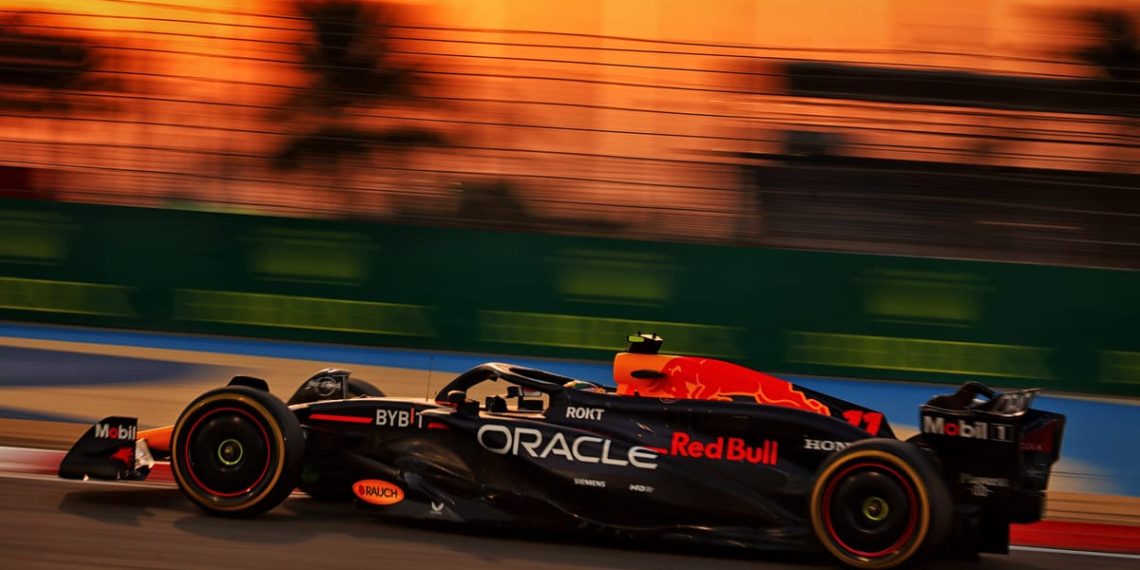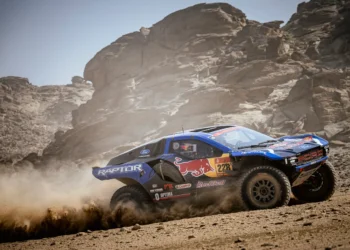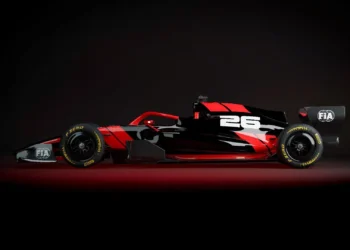Formula 1 is known for its secretive nature during testing, making it difficult to determine its true performance. Factors such as fuel load, tire choice, power modes, and track conditions can significantly influence lap times. However, despite these challenges, I will try to predict what may happen in the upcoming Bahrain Grand Prix based on the available data.
To analyze the test results, I converted each driver’s fastest lap time into a percentage. The fastest lap time serves as a reference, and each driver’s time is measured as a percentage relative to that reference. I applied the same methodology to each team, considering the fastest driver’s time as representative of the team’s performance.
To account for variations in tire choice, I adjusted the lap times based on what they would have been if all drivers had used the medium C3 compound for their fastest lap. This adjustment is necessary because softer tires tend to provide faster lap times but degrade more quickly, while harder tires offer more durability but are slightly slower overall.
Based on this analysis, here is my assessment of each team’s performance:
1 – Carlos Sainz 1m30.421s (driver reference)
4 – Charles Leclerc 1m30.832s (+0.457%)
Ferrari showed stability and consistency during testing. Both drivers performed well, and the car seems to handle the harder tires well. Ferrari finished strong last year and appears to have maintained that momentum into the new season. However, I don’t believe they are ahead of Red Bull, but the difference between the two teams will be small. Ferrari likely used approximately 25 kg of fuel, leaving room for improvement in qualifying.
2 – Sergio Perez 1m30.679s (+0.285%)
3 – Max Verstappen 1m30.755s (+0.371%)
Red Bull initially appeared dominant during testing, but as time went on, other teams improved while Red Bull’s progress seemed to stagnate. The car had some initial understeer issues, but those were quickly resolved. I expect Red Bull to have a similar performance to last year, but the difference between them and the top teams will be smaller. They likely used at least 30 kg of fuel, indicating room for improvement in qualifying.
5 – George Russell 1m30.868s (+0.497%)
7 – Lewis Hamilton 1m31.066s (+0.717%)
Mercedes introduced a significantly different car this year, both mechanically and aerodynamically. The team is still learning about the new car, but it appears stable on the track, with quick entry into corners and occasional throttle sensitivity. Although Mercedes doesn’t yet have a car to rival Red Bull or Ferrari, the new design is expected to be more responsive to future developments. Currently, Mercedes is likely the third-best team, with McLaren as the closest competitor.
6 – Oscar Piastri 1m31.030s (+0.677%)
10 – Lando Norris 1m31.256s (+0.929%)
The McLaren car showed stability and consistency during testing, with both drivers heading in the same direction. This is a good sign for the team’s development. McLaren believes it has a positive development path and a car capable of challenging for podium positions. I expect McLaren to be on the same level as Mercedes, competing for the third or fourth-best team. Their two drivers form a strong duo that can defend against other competitors.
8 Zhou Guanyu 1m31.147s (+0.807%)
17 Valtteri Bottas 1m32.227s (+2.008%)
The Sauber car appeared to lack grip on the track, using more space on the track compared to other teams. The team made adjustments to the car’s balance during testing, including the introduction of a new floor. It is difficult to evaluate day-to-day improvement due to constantly changing track conditions. Zhou Guanyu’s fast lap time at the end of the last day suggests a lighter fuel load, indicating room for improvement in qualifying. Overall, Sauber is expected to be in the middle of the midfield, with good performance on good days and difficulties on bad days.
9 – Fernando Alonso 1m31.159s (+0.821%)
15 – Lance Stroll 1m32.029s (+1.788%)
Aston Martin’s performance during testing was surprising, with the car showing stability and consistency on the track. The relatively low position of the team may be attributed to fuel load and a focus on completing the testing program without chasing glory laps. I expect at least one of the Aston Martin drivers to comfortably secure a position in the top ten, but breaking into the top eight may be a challenge.
12 – Yuki Tsunoda 1m31.275s (+0.944%)
14 – Daniel Ricciardo 1m31.861s (+1.601%)
AlphaTauri had a promising test last year, but their performance dropped in the first race weekend’s qualifying. This year, Tsunoda’s lap time suggests improvement, and both drivers will be aiming for better results in Bahrain. AlphaTauri has a better car compared to last year, putting them at the front of the midfield pack. However, there will still be a gap to the top five teams.
11 – Alex Albon 1m31.484s (+1.182%)
20 – Logan Sargeant 1m33.078s (+2.955%)
The Williams car does not appear to have made significant progress from last year. Although Albon showed the ability to extract a fast lap in qualifying, the car’s performance is crucial for consistent results. Williams also faced reliability issues during testing that need to be resolved. Finishing races will be essential for Williams to make big strides this season.
13 – Nico Hulkenberg 1m31.686s (+1.407%)
19 – Kevin Magnussen 1m33.053s (+2.927%)
The Haas car appears stable and consistent on the track but lacks speed compared to other teams. The team focused on resolving tire degradation issues during testing, conducting longer stints. Hulkenberg’s fast lap time at the end of the test suggests a lighter fuel load, indicating room for improvement in qualifying. Haas is expected to be in the middle of the backfield, with the sixth-best performance on good days and the eighth-best on bad days.
16 – Esteban Ocon 1m32.061s (+1.824%)
18 – Pierre Gasly 1m32.805s (+2.651%)
The Alpine car appeared inconsistent and difficult to drive during testing. The drivers seemed to struggle in every corner, making similar mistakes. The fastest lap times of 2023 and the test results indicate that there is still room for improvement in terms of performance. The gap between the top teams and the midfield has widened, which is concerning. Alpine needs to address the car’s inconsistency to compete effectively.
In summary, I expect Red Bull to lead the pack, closely followed by Ferrari. Mercedes and McLaren will be in contention, with Aston Martin not far behind. The battle in the midfield will be intense, with AlphaTauri, Williams, and Haas fighting for positions. Alpine should follow, but they need to address the car’s inconsistency. In the end, the final results will depend on each team’s ability to perform on race day. We will have a clearer picture of the teams’ true performance after qualifying on Saturday.
© 2024
Football star Lionel Messi signs a contract with Paris Saint-Germain (PSG) and becomes the newest addition to the French club. The transfer of the Argentine player was officially announced on Tuesday, August 10. Messi signed a two-year contract with PSG, with the option to extend for another season.
After a long career at Barcelona, where he won numerous titles and became one of the greatest players in history, Messi decided to leave the Catalan club due to financial problems. PSG, with its financial power, managed to make an irresistible offer to the player, who promptly accepted.
Messi’s signing by PSG is a milestone for the French club, which has been seeking to win the UEFA Champions League for years. With the arrival of the Argentine superstar, PSG becomes one of the favorites for the title. Furthermore, Messi’s signing also strengthens the team for the French Championship, where the club aims to maintain its dominance.
Messi joins a star-studded squad at PSG, which already includes names like Neymar and Mbappé. The expectation is that the trio will form a devastating attack and lead the club to win the major titles of the season. Messi’s arrival is also expected to boost PSG commercially, with a significant increase in shirt sales and sponsor interest.
There is still no information about Messi’s debut for PSG, but fans are already eager to see him on the field wearing the club’s jersey. The signing of the Argentine certainly brings new energy and expectation to the Parisian fans, who hope to see their team shine in national and international competitions.
With Messi’s transfer, Barcelona loses one of its greatest idols and will have to restructure for the next season. The Catalan club is facing financial problems and will have to find solutions to fill the gap left by the Argentine star. Messi’s departure also marks the end of an era at Barcelona, which will now have to seek new references and leadership on the field.









